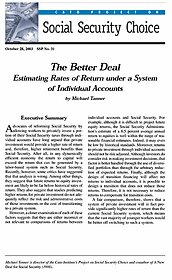However, a closer examination of each of these factors suggests that they are either incorrect or not relevant to comparisons of returns between individual accounts and Social Security. For example, although it is difficult to project future equity returns, the Social Security Administration’s estimate of a 6.5 percent average annual return to equities is well within the range of reasonable financial estimates. Indeed, it may even be low by historical standards. Moreover, returns to private investment through individual accounts should not be risk adjusted. Although investors do consider risk in making investment decisions, that factor is better handled through the use of diversified portfolios than through the arbitrary reduction of expected returns. Finally, although the design of transition financing will affect net returns to individual accounts, it is possible to design a transition that does not reduce those returns. Therefore, it is not necessary to reduce returns to compensate for transition costs.
A fair comparison, therefore, shows that a system of private investment will in fact provide significantly higher rates of return than the current Social Security system, which means that the vast majority of younger workers would be better off switching to such a system.


